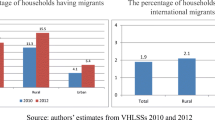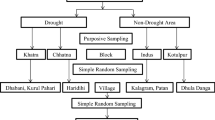Abstract
This study explores the financial costs, time involved in migration and benefits at household level. A household survey has been conducted to investigate about characteristics of migrants, transaction costs and sources of financing by which overseas migration is financed. Results of PSM technique explored that overseas migration conveys worthwhile benefits as measured by their total expenditures, food expenditures, non-food expenditures, clothing expenditures, expenditures on pots and pans, expenditures on vehicles and saving levels. Establishment of technical training institutions, creation of micro-finance institutions and enhancing their functioning as well as sensitization about ‘Pakistan Remittance Initiative’ would be some of the policy options in order to tackle with the problem.


Similar content being viewed by others
Notes
These key informant interviews identified 25 such villages. From this list of 25 villages, 4 villages have selected randomly which are Chak No. 517 GB, Chak No. 330 GB, Chak No. 342 GB, Chak No. 341 GB.
References
Acosta, P., Fajnzylber, P., & Lopez, J. H. (2007). The impact of remittances on poverty and human development: Evidence from Latin American household surveys. Working Paper No. 4247, World Bank.
Airola, J. (2007). The use of remittance income in Mexico. International Migration Review, 41(4), 850–859.
Anyanwu, J. C., & Erhijakpor, A. E. O. (2010). Do international remittances affect poverty in Africa? African Development Review, 22(1), 51–91.
Crush, J., & Frayne, B. (2007). The migration and development nexus in Southern Africal introduction. Development Southern Africa, 24(1), 1–23.
Cuong, N. V. (2008). Impacts of international and internal remittances on household welfare: Evidence from Viet Nam. Paper No. 25770, MPRA.
D’agostino, R. B. (1998). Tutorial in Biostatistics propensity score methods for bias reduction in the comparison of a treatment to a non-randomized control group. Statistical Medicine, 17, 2265–2281.
D’Istano, F., Fouskas, P., & Verde, M. (2015). Determinants of well-being among legal and illegal immigrants: Evidence from South Italy. Social Indicators Research,. doi:10.1007/s11205-015-0924-7.
Dehejia, R. H., & Wahba, S. (1999). Casual effects in non-experimental studies: Reevaluating the evaluation of training programs. Journal of the American Statistical Association, 94(448), 1053–1062.
Government of India. (1908). Digital South Asia Library, Imperial Gazetter of India, 23, 406. http://dsal.uchicago.edu/reference/gazetteer/pager.html?objectid=DS405.1.I34_V23_412.gif. Accessed 10 March 2013.
Government of Pakistan (1998). Statistics Division, Population Census Organization, District Census Report of Toba Tek Singh.
Gupta, S., Pattillo, C. A., & Wagh, S. (2009). Effect of remittances on poverty and financial development in Sub-Saharan Africa. World Development, 37(1), 104–115.
Heinrich, C., Maffioli, A. & Vazquez, G. (2010). A premier for applying propensity Score Matching.Technical Notes No. IDB-TN-161, Office of Strategic Planning and Development Effectiveness, Inter-American Development Bank.
Jones, H., & Kittisuksathit, S. (2003). International labour migration and quality of life: Findings from rural Thailand. International Journal of Population Geography, 9, 517–530.
Koc, I., & Onan, I. (2004). International migrants’ remittances and welfare status of the left-behind families in Turkey. International Migration Review, 38(1), 78–112.
Lokshin, M., Osmolovski, M. B., & Glinskaya, E. (2010). Work-related migration and poverty reduction in Nepal. Review of Development Economics, 14(2), 323–332.
Mansuri, G. (2006). Migration, school attainment, and child labor: evidence from rural Pakistan. Working paper No. 3945, World Bank.
Maposa, F. (2007). Remittances and development: The impact of migration to South Africa on rural livelihoods in Southern Zimbabwe. Development Southern Africa, 24(1), 123–136.
Mckenzie, D., Gibson, J. & Stillman, S. (2006). How important is selection? Experimental vs non-experimental measures of the income gains from migration, Working Paper in Economics No. 3/06, Department of Economics, University of Waikato, Hamilton, New Zealand.
Rosenbaum, D. R., & Rubin, D. B. (1983). The central role of the propensity score in observational studies for causal effects. Biometrika, 70(1), 41–55.
Satti, S. L., Hassan, M. S., & Hayat, F. (2015). Economic growth and flow of remittances. Social Indicators Research,. doi:10.1007/s11205-015-1003-9.
Sharma, M. P. (2013). International contract-based migration, remittances, and household well-being in the western province of Sri Lanka. International Migration, 51(S1), 216–248.
Sharma, M. & Zaman, H. (2009). Who migrates overseas and is it worth their while? An assessment of household survey data from Bangladesh.Working Paper No. 5018, World Bank.
State Bank of Pakistan. (2015). http://www.sbp.org.pk/ecodata/Homeremit.pdf. Accessed 20 August 2015.
The World Bank (2014). Migration and development brief. Migration and Remittances Team, Development Prospects Group. http://siteresources.worldbank.org/INTPROSPECTS/Resources/334934-1288990760745/MigrationandDevelopmentBrief22.pdf.
The World Bank, Migration and Remittances Team. (2015). http://econ.worldbank.org/WBSITE/EXTERNAL/EXTDEC/EXTDECPROSPECTS/0,contentMDK:21121930~menuPK:3145470~pagePK:64165401~piPK:64165026~theSitePK:476883,00.ht. Accessed 2 May 2015.
United Nations (2013). UN News Centre, New York. http://www.un.org/apps/news/story.asp?NewsID=45819#.UleA3IZkNSk. Accessed 11 October 2013.
Author information
Authors and Affiliations
Corresponding author
Rights and permissions
About this article
Cite this article
Javed, M., Awan, M.S. & Waqas, M. International Migration, Remittances Inflow and Household Welfare: An Intra Village Comparison from Pakistan. Soc Indic Res 130, 779–797 (2017). https://doi.org/10.1007/s11205-015-1199-8
Accepted:
Published:
Issue Date:
DOI: https://doi.org/10.1007/s11205-015-1199-8




